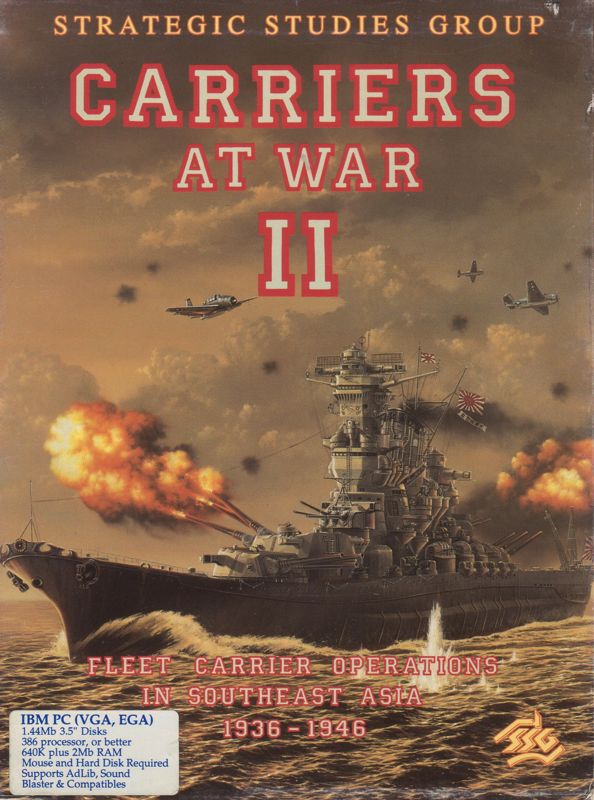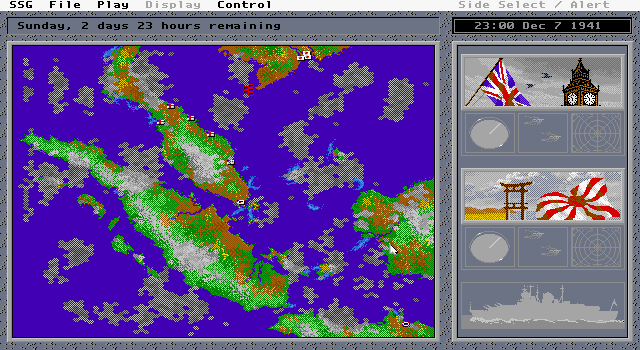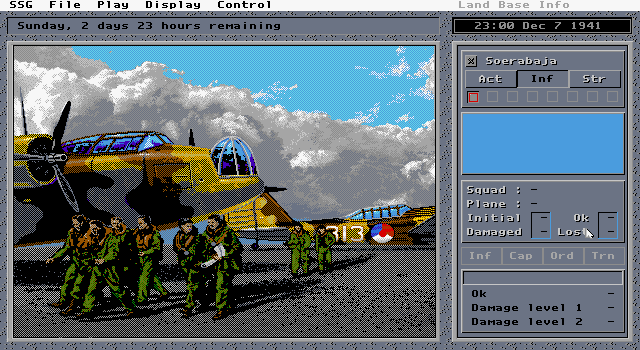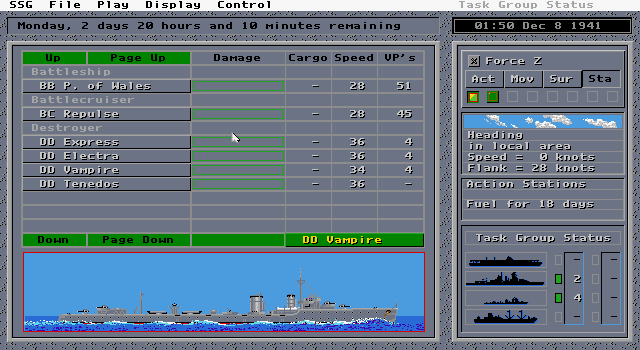Retro Replay Review
Gameplay
Carriers at War II builds on its predecessor’s solid foundation by delivering deep, turn-based naval warfare mechanics that emphasize planning and strategic thinking. Every scenario—from the tense morning hours approaching the Java Sea to the fierce night strikes around Okinawa—demands meticulous carrier task force management. Players must juggle aircraft launches, reconnaissance flights, and anti-submarine patrols, all while keeping an eagle eye on fuel, ordnance, and maintenance for each squadron.
(HEY YOU!! We hope you enjoy! We try not to run ads. So basically, this is a very expensive hobby running this site. Please consider joining us for updates, forums, and more. Network w/ us to make some cash or friends while retro gaming, and you can win some free retro games for posting. Okay, carry on 👍)
The game’s interface streamlines complex operations into intuitive menus, making fleet coordination feel manageable rather than overwhelming. Selecting strike targets, plotting waypoints for destroyer screens, and ordering air defense CAP (Combat Air Patrol) are all accomplished with just a few clicks. This balance between depth and accessibility ensures that both series veterans and newcomers can jump in with minimal frustration while still encountering nuanced tactical challenges.
Scenario length and variety are impressive, covering ten pivotal years of Pacific theater development from 1936 to 1946. Early-war engagements in Port Darwin capture the vulnerability of Allied carriers surprised by faster Japanese tactics, whereas later scenarios like Leyte Gulf and Okinawa showcase massive multi-carrier battle groups and the dawn of kamikaze attacks. Each mission feels distinct, forcing players to adapt their doctrines to evolving ship classes, aircraft capabilities, and detection technologies.
Graphics
While Carriers at War II’s visuals may appear modest by modern standards, they excel in clarity and functional design. The hex-based map lays out coastlines, islands, and sea zones in crisp, easily decipherable colors. Ship and plane icons are small but distinct, changing shape or color to indicate damage, fuel levels, or readiness states. The result is a battlefield view that never feels cluttered, even when dozens of units converge in a single area.
Animations are kept to a tasteful minimum, focusing more on streamlined information than flashy effects. Aircraft launches and recoveries play out as concise pop-up windows with representative silhouettes—enough to convey the action without bogging down turn resolution times. Tactical overlays, such as radar ranges and anti-air bubbles, appear semi-transparently over the map grid, providing essential intel at a glance.
Audio design complements the visuals with period-appropriate jingles, alert tones, and brief radio chatter. Dive-bomb runs and torpedo strikes are represented by simple yet gratifying sound cues. Although there’s no fully voiced cutscene or orchestral score, the combination of minimalist graphics and strategic sound design creates an immersive atmosphere that keeps the focus squarely on decision-making rather than spectacle.
Story
As a historical wargame, Carriers at War II doesn’t follow a linear narrative but instead presents ten standalone scenarios that collectively illustrate the evolving dynamics of carrier warfare. Each scenario opens with a succinct historical briefing, outlining strategic objectives, order of battle, and contextual background. These introductions read like mini-documents, detailing the operational stakes at Java Sea, Port Darwin, Leyte Gulf, and Okinawa, setting clear goals and constraints.
The lack of a traditional character-driven plot is offset by the player’s ability to craft their own stories through emergent gameplay. Seeing a squadron your command trains inflict decisive damage on an enemy battleship, or narrowly avoiding a night torpedo ambush, creates personal triumphs and tense “what-if” moments. Through repeated playthroughs, you’ll begin to anticipate Japanese and Allied doctrines, turning historical learning into hard-won tactical wisdom.
Moreover, the game’s dedication to period accuracy deepens the immersion. Aircraft performance curves change over the decade, reflecting real-world technological advancements. Ship armor thickness, radar ranges, and torpedo reliability are all modeled to mirror historical data. This scholarly attention to detail transforms each campaign into an educational journey as much as an entertainment experience.
Overall Experience
Carriers at War II delivers a rewarding blend of strategic depth and historical authenticity, making it a must-play for aficionados of naval simulations. The turn-based structure allows for thorough deliberation, while the array of scenarios offers both breadth and longevity. Whether you’re repelling Japanese fleets in early-war skirmishes or commanding juggernaut carrier battle groups in 1945, each engagement feels fresh and challenging.
Replayability is exceptionally high thanks to adjustable difficulty settings, alternate order-of-battle options, and the in-game editor that lets you customize fleets or create entirely new scenarios. Multiplayer hotseat support further extends the game’s lifespan, inviting head-to-head showdowns that test your wits against human rivals rather than AI patterns.
While modern gamers seeking high-octane action may find the graphics and pacing understated, Carriers at War II’s strengths lie in its cerebral demands and historical fidelity. It’s an experience best enjoyed with a notepad and a penchant for research, offering hours of engrossing planning and execution. For anyone drawn to naval warfare’s strategic heights, this title stands out as an engaging, informative simulation that honors the complexity of carrier operations during World War II.
 Retro Replay Retro Replay gaming reviews, news, emulation, geek stuff and more!
Retro Replay Retro Replay gaming reviews, news, emulation, geek stuff and more!







Reviews
There are no reviews yet.